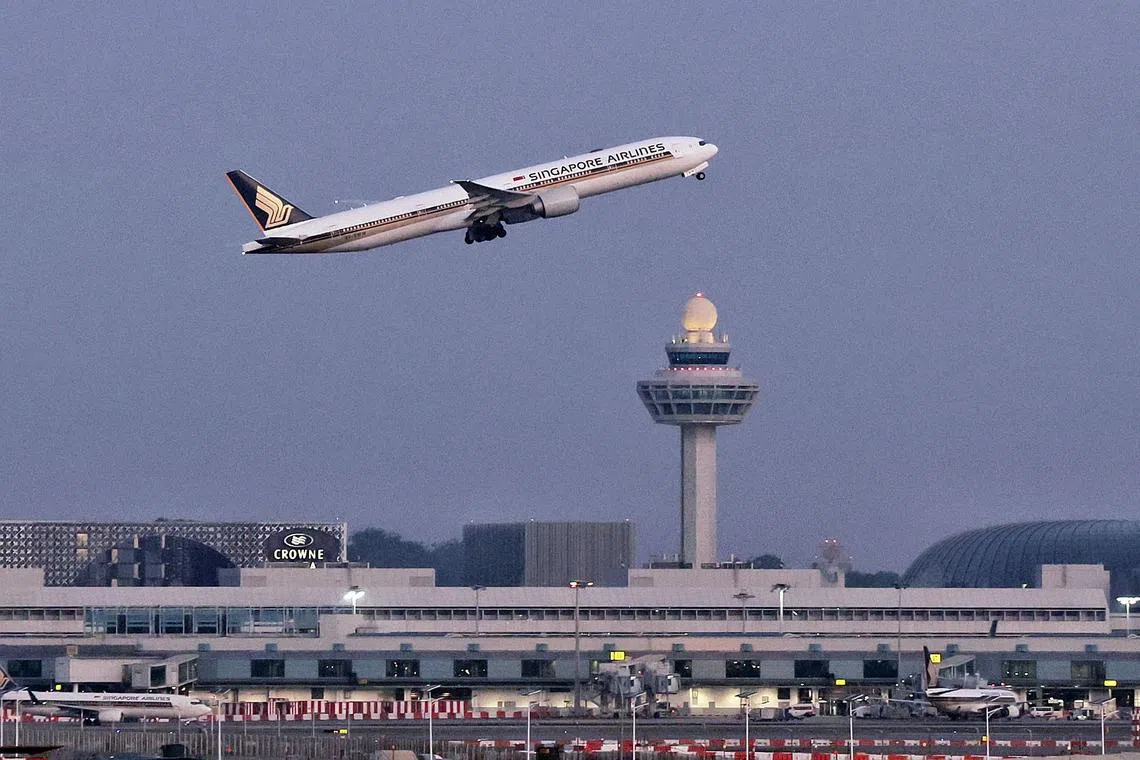Number of air travellers to cross 5 billion for first time in 2025; average fares to drop: Iata
Sign up now: Get ST's newsletters delivered to your inbox

Some 5.22 billion passengers are expected to take to the skies in the coming year, said the International Air Transport Association.
PHOTO: ST FILE
Follow topic:
GENEVA – The number of air travellers around the world is expected to surpass five billion for the first time in 2025 as travel becomes increasingly affordable, said the International Air Transport Association (Iata).
Some 5.22 billion passengers are expected to take to the skies in the coming year, a 6.7 per cent increase from the 4.89 billion forecast for 2024, the airline industry body said at its global media day in Geneva, Switzerland, on Dec 10.
Airfares and airlines’ revenue sources other than ticketing – which are collectively known as passenger yield – are expected to fall by 3.4 per cent in 2025.
At US$380 (S$510), the average return airfare in 2025 is forecast to be 1.8 per cent lower than in 2024 (US$387).
Passenger demand – measured by revenue passenger kilometres, or the volume carried by airlines – is set to expand by 8 per cent in 2025, overtaking an expected 7.1 per cent expansion in capacity.
Demand in the Asia-Pacific, the largest market globally, will continue to rise. It is expected to grow 18.6 per cent in 2024, driven in part by visa relaxations in countries such as China and Vietnam, and is set to rise by another 11.7 per cent in 2025.
As capacity increases steadily, the number of flights worldwide is expected to hit the 40 million mark for the first time in 2025, rising by 4.6 per cent from 2024, said Iata at the yearly briefing in its Geneva office attended by more than 100 journalists from around the world.
The association represents about 340 airlines, including home-grown carriers Singapore Airlines and Scoot, that make up more than 80 per cent of global air traffic.
Iata expects profitability of airlines to be up in 2025, despite supply chain and cost pressures exacting a continued toll.
On the whole, the industry is projected to rake in a net profit of US$36.6 billion in 2025, an improvement from the US$31.5 billion expected in 2024 – helped in part by lower oil prices. Total revenues are set to exceed US$1 trillion for the first time in the coming year, at US$1.007 trillion.
The average net profit from every passenger flown is expected to come in at US$7.
Although revenues are set to rise, airlines will bear a total of US$940 billion in costs, thus retaining a net profit margin of just 3.6 per cent, Iata director-general Willie Walsh said.
“Put another way, the buffer between profit and loss – even in the good year that we are expecting of 2025 – is just US$7 per passenger.
“With margins that thin, airlines must continue to watch every cost and insist on similar efficiency across the supply chain,” added Mr Walsh, an industry veteran who was chief executive of British Airways.
The US$940 billion in costs forecast to be borne by airlines in 2025 will be a 4 per cent increase from 2024.
Even though jet fuel prices dropped to US$70 a barrel in September for the first time since the Russia-Ukraine war erupted in early 2022, costs in other areas are up. These include labour costs as well as maintenance costs owing to aircraft groundings and an ageing global aircraft fleet, which has an average age of 14.8 years now, up from 13.6 years on average in the last 34 years.
About 5,000 aircraft have been taken out of service temporarily, or about 14 per cent of the total worldwide fleet of about 35,000 planes, Iata said. Of these, about 700 are on the ground for inspections after a series of engine defects led to the grounding of planes around the world.
An estimated 1,254 planes were delivered in 2024, down sharply from the peak of 1,813 aircraft in 2018. Deliveries are expected to climb to 1,802 in 2025, although this is still well below initial expectations of about 2,300 deliveries, said Iata.
On the supply chain woes that continue to bedevil airlines, Mr Walsh said the failures on the part of plane-makers Boeing and Airbus as well as engine manufacturers to deliver the products that they promised remain cause for major concern.
This restricted the growth for some airlines in 2024. “Despite the fact that it doesn’t appear to be getting any worse, there’s no evidence of it getting better, and we now see this disruption continuing for quite a number of years,” Mr Walsh added.
Iata flagged global conflict, the incoming Trump administration in the US and fluctuating oil prices as key risks to the aviation industry in 2025.
For example, the industry’s prospects could be dampened should the wars in Europe and the Middle East spread.
Uncertainties over the policies of the Trump administration also loom large. Tariffs and trade wars, for instance, would likely hit demand for air cargo and have the potential to affect business travel.
“However, should the business-friendly stance of the first Trump administration continue into this term, gains from deregulation and business simplification could be significant,” Iata said.
The topic of green aviation fuels – made from waste materials such as used cooking oil and animal fat – also received attention at the Geneva event.
Iata expressed disappointment at their slow production after the volumes produced in 2024 fell short of earlier estimates.
In 2024, 1.3 billion litres of such fuel have been produced – forming a mere 0.3 per cent of global jet fuel produced, and below the 1.9 billion litres estimated for the year.
Iata attributed this to key US production facilities postponing the ramp-up in production until the first half of 2025.
In 2025, production is expected to rise to 2.7 billion litres, constituting 0.7 per cent of total aviation fuel made.
To hit the target of having such fuel make up 5 per cent of fuel consumption by 2030, about 17.5 billion litres of eco-friendly fuel will have to be produced each year, Iata said previously.


